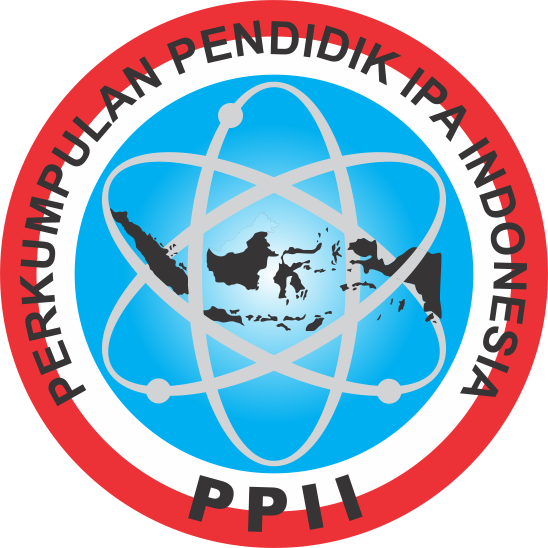Perubahan Konsepsi Mahasiswa Calon Guru Fisika pada Topik Alat Optik Mata Menggunakan Teks Perubahan Konseptual (TPK) Berbantuan Analogi
(1) Universitas Negeri Makassar
(*) Corresponding Author
DOI: https://doi.org/10.26858/semnaspendipa.v3i1.57069
Abstract
Penelitian ini merupakan jenis penelitian deskriptif kualitatif yang bertujuan untuk menggambarkan konsepsi dan miskonsepsi mahasiswa calon guru fisika tentang konsep alat optik pada mata serta bertujuan untuk mendeskripsikan perubahan konsepsi mahasiswa calon guru fisika tentang alat optik mata setelah diterapkannya Teks Perubahan Konsep (TPK) berbantuan analogi. Langkah-langkah yang dilakukan adalah 1) Observasi dan pendefinisian, 2) Perancangan TPK berbantuan analogi, 3) penjaringan konsepsi mahasiswa, 4) implementasi TPK berbantuan analogi, 5) analisis data, dan 5) interpretasi data perubahan konsepsi mahasiswa. Subyek penelitian ini adalah mahasiswa calon guru fisika yang sedang memprogram mata kuliah Fisika Dasar II semester genap tahun 2023 di Jurusan Fisika Fakultas MIPA Universitas Negeri Makassar sebanyak 35 orang. Hasil penelitian ini menunjukkan bahwa pada umumnya masih terjadi miskonsepsi khususnya pada konsep prinsip kerja mata sebagai alat optik; konsep kekuatan akomodasi mata; konsep kelainan mata rabun sebagai alat optik; dan konsep kelainan mata hipermetropia. Dapat disimpulkan bahwa sebagian besar calon guru siswa dengan konsepsi awal yang berbeda-beda dapat mencapai pemahaman konseptual yang mendalam dan utuh melalui proses konstruksi (tidak mempunyai konsepsi untuk menjadi konsepsi ilmiah) dan rekonstruksi (miskonsepsi menuju konsepsi ilmiah) melalui Teks perubahan Konseptual Berbantuan Analogi.
Keywords
Full Text:
PDFReferences
Balci, C. (2006). Conceptual change text oriented instruction to facilitate conceptual change in rate of reaction concepts. Tesis S2 School of Natural and Applied Sciences of Middle East Technical University.
Baser, M. (2006). Effects of conceptual change and traditional confirmatory simulations on pre-service teachers’ understanding of direct current circuits. Journal of Science Education and Technology, Vol. 15.
Cetin-Dindar, A dan Omer Geban (2011). Development of a four-tier test to assess high school students’ understanding of acids and bases. Procedia Social and Behavioral Sciences. Vol. 15 (2011) 600-604.
Dilber, R., Duzgun, B. (2008), Effectiveness of Analogy on Students’ Success and Elimination of Misconceptions, Lat. Am. J. Phys. Educ. Vol. 2, No. 3, Sept. 2008
Gentner, D., & Stevens, A. L. (Eds.). (2014). Mental models. Psychology Press.
Gurel, D. K., and Eryilmaz. A,. (2013). A Content Analysis of Physics Textbooks as a Probable Sources of Misconceptions in Geometric Optics. Journal of Education 28(2), 234-245.
Harrison, A. G. (1993). A review of textbook analogies for the refraction of light: Proceedings of 18th annual conference of the Western Australian science education association. Perth Western Australia (20-28).
Harrison, A. G. & Treagust, D. F. (1993).Teaching-with-analogies: A case study in grade 10 optics. Journal of research in science teaching. 30, 1291-1307.
Harrison, A. & Treagust, D. (2000). Learning about atoms, molecules, and chemical bonds: A case study of multiple-model use in grade 11 chemistry. Science & Education, 84(3), 352–381.
Herausgeber, Bernd. Z., Rafl. T. (2013). A Practical Application of Physics Education Research Informed Teaching Interventions in a First-year Physics Service Course. Journal of Technical Education (JOTED), ISSN 2198-0306.
Kucukozer, H., Kocakulah, S. (2007). Secondary School Students’ Misconception about Simple Electric Circuits, Journal of Turkish Science Education, 4 (1), 101 – 115.
Kaur, G. (2012). Drawing Insights from Cognitive Science for a Strengthened Teacher Preparation: Learning from Optics. International Journal for Cross-Disciplinary Subjects in Education (IJCDSE),3 (2), 11-12 .
National Research Council. (1996). National Science Education Standards. Washington DC: National Academy Press.
Odabasi, Y.C. & Sengoren, S.K. (2014). Physics Candidate Teachers’ Alternative Concepts about Image and Shadow Formation and Opinions about High School Students’ Alternative Concepts on These Topics. Balkan Physics Letters, 22 (221005), 43-59.
Ouattara, F. & Boudaone, B. (2012). Teaching and Learning in Geometrical Optics in Burkina Faso Third from Classes: Presentation and Analysis on Class Observations Data and Students’ Performance. Frederic. British Journal of Science, 5 (1), 23-25.
Tural, G. (2015). Cross-Grade Comparison of Students’ Conceptual Understanding with Lenses in Geometric Optics. Science Education International, 26 (3), 325-343.
Uzun, S., Alev, N. & Karal, I.S. (2013). A cross-age Study of an Understanding of Light and Sight Concepts in Physics. Science Education International, 24 (2), 129-149.
Sugiyono, (2016). Metode Penelitian Pendidikan Pendekatan Kuantitatif, Kualitatif, Dan R&D. Bandung:alfabeta.
Suparno, P. (2005). Miskonsepsi dan perubahan konsep dalam pendidikan fisika. Jakarta: Grasindo.
Article Metrics
Abstract view : 42 times | PDF view : 7 timesRefbacks
- There are currently no refbacks.
Copyright (c) 2023 Andi Sri Astika Wahyuni







 muh.alhamsatnur@unm.ac.id/ semnas.pendipa@unm.ac.id
muh.alhamsatnur@unm.ac.id/ semnas.pendipa@unm.ac.id